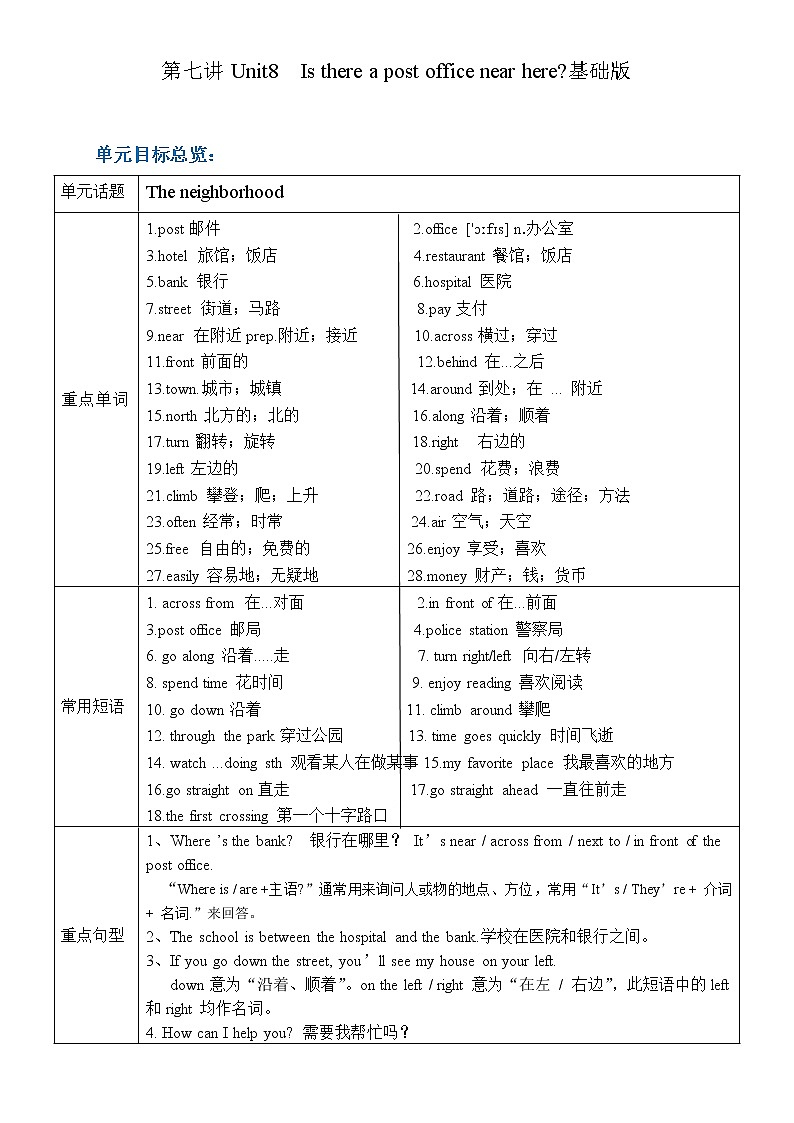





所属成套资源:初一人教新目标版英语下册(春季班)讲义
- 新目标初一下册(春季班)英语 第7讲 Unit 7 It's raining 拔尖版 试卷 试卷 2 次下载
- 新目标初一下册(春季班)英语 第7讲 Unit 7 It's raining 提升版 试卷 试卷 2 次下载
- 新目标初一下册(春季班)英语 第8讲 Unit 8 Is there a postoffice near here? 拔尖版 试卷 试卷 2 次下载
- 新目标初一下册(春季班)英语 第8讲 Unit 8 Is there a postoffice near here? 提升版 试卷 试卷 4 次下载
- 新目标初一下册(春季班)英语 第9讲 Unit 9 What does he look like? 基础版 试卷 试卷 2 次下载
新目标初一下册(春季班)英语 第8讲 Unit 8 Is there a postoffice near here? 基础版 试卷
展开这是一份新目标初一下册(春季班)英语 第8讲 Unit 8 Is there a postoffice near here? 基础版,文件包含新目标初一下册春季班英语第8讲Unit8Isthereapostofficenearhere基础版教师版doc、新目标初一下册春季班英语第8讲Unit8基础版学生版doc等2份试卷配套教学资源,其中试卷共20页, 欢迎下载使用。
第七讲Unit8 Is there a post office near here?基础版
单元目标总览:
单元话题 | The neighborhood |
重点单词 | 1.post邮件 2.office ['ɔːfɪs] n.办公室 3.hotel 旅馆;饭店 4.restaurant餐馆;饭店 5.bank 银行 6.hospital医院 7.street 街道;马路 8.pay支付 9.near 在附近prep.附近;接近 10.across横过;穿过 11.front前面的 12.behind在...之后 13.town.城市;城镇 14.around到处;在 ... 附近 15.north北方的;北的 16.along沿着;顺着 17.turn翻转;旋转 18.right 右边的 19.left左边的 20.spend 花费;浪费 21.climb攀登;爬;上升 22.road 路;道路;途径;方法 23.often经常;时常 24.air空气;天空 25.free 自由的;免费的 26.enjoy享受;喜欢 27.easily容易地;无疑地 28.money财产;钱;货币 |
常用短语 | 1. across from 在...对面 2.in front of在...前面 3.post office邮局 4.police station警察局 6. go along沿着.....走 7. turn right/left向右/左转 8. spend time花时间 9. enjoy reading喜欢阅读 10. go down沿着 11. climb around攀爬 12. through the park穿过公园 13. time goes quickly时间飞逝 14. watch ...doing sth 观看某人在做某事15.my favorite place 我最喜欢的地方 16.go straight on直走 17.go straight ahead 一直往前走 18.the first crossing第一个十字路口 |
重点句型 | 1、Where ’s the bank? 银行在哪里? It’s near / across from / next to / in front of the post office. “Where is / are +主语?”通常用来询问人或物的地点、方位,常用“It’s / They’re + 介词 + 名词.”来回答。 2、The school is between the hospital and the bank.学校在医院和银行之间。 3、If you go down the street, you’ll see my house on your left. down意为“沿着、顺着”。on the left / right意为“在左 / 右边”,此短语中的left和right均作名词。
还可说成:What can I do for you? May I help you? Could/Can I help you? Do you need any help? Is there anything I can help (you) with? Is there anything I can do for you? 5. I’m new in town. 我新来此地。 town: “所居住的地方”或城市里的“闹市区;城里”,为不可数名词. 6. Is there a hotel near here? / Is there a hotel in the neighborhood?这附近有个宾馆吗? 7. Just go straight and turn left. 直走向左拐 8. It’s down Center Street on the right. 它就在中心大街的右边 9. It’s next to a supermarket. 挨着一个超市。 10. Excuse me, where is the railway station? 对不起,请问火车站在哪儿? 11. Go down this street, and turn to the left at the first crossing. 沿着这条街走,在第一个十字路口向左拐。 12.Go straight on, then turn right at the second crossing. 直走,在第二个十字路口向右拐。 13. Go straight ahead until you come to a tall building, then turn left. 一直往前走,一直走到一座高楼,然后向左拐。 14.There is a big park across from the supermarket.有个大公园在超市对面。 15. To get there, I usually walk out and turn right on Bridge Road.要去那儿(动物园)的话, 我通常步行外出,在大桥路向右拐。这是英语行文的一种方式: 16. The best things in life are free! 生活中最美好的东西是免费的呀! 17. It is very quiet and I enjoy reading there. 很安静而且我喜欢在那里看书。enjoy: “从中得到乐趣;欣赏;喜欢” enjoy doing… = like doing sth.“喜欢做某事;享受做某事所带来的愉悦和乐趣” enjoy oneself 过得快乐,玩得愉快= have fun = have a good time |
基本要求 | 1. 要求掌握重点单词和词组 2. 掌握日常交际用语 3. 教学重点:使用祈使句、条件状语从句等为他人指路,there be 句型 |
Section A 考点知识梳理
【知识点详解】
1、 Excuse me.打扰一下。
Excuse me的意思是“对不起、请原谅、打扰一下”。这是英语中经常用到的表示客气的礼貌用语,用于向对方提出请求、询问情况、打扰或者麻烦别人等情景中。Excuse me 具体用于以下几种情况:
(1)向别人问路的时候。
◆Excuse me, where is the bank? 劳驾,请问银行在哪里?
(2)客气地向别人提出请求(允许)。
◆Excuse me, may I use your bike? 对不起,我可以用一用你的自行车吗?
(3)向别人打听或者询问情况的时候。例如:
◆Excuse me, is this your bike? 麻烦一下,这是你的自行车吗?
(4)和别人谈话的时候需要中断或者做别的事情。例如:
◆Excuse me, just a moment. 对不起,请稍等一下。
2、Is there a bank near here?
(1)这是there be的一般疑问句,把be动词放在句子的开头,句子结尾用问号,读句子的时候用升调。对于这类句子的肯定回答是:Yes, there is.或者Yes, there are.否定回答是:No, there isn’ t.或者No, there aren’ t.
注意:there be表示“某地有某物”;have (has)表示“某人有某物”。同学们在表达的时候不能相混,一定要分清楚。例如:
◆There is a book on the desk. 桌子上有一本书。
◆I have a book on the desk. 我有一本书在桌子上。
(2)结构:there is /are +名词+介词短语(表示地点)/ 地点副词。
There is a pen and three books on the desk. 书桌上有一支钢笔和三本书。
①否定形式:在be动词后面加not
◆There is not a post office near here. 这儿附近没有邮局。
②一般疑问句形式:将be动词移到there前:
◆---Are there two balls in the bag? 包里有两个球吗?
---Yes, there are. (肯定回答)/ No, there aren't.(否定回答)
③对句子中的数字进行提问。
◆There are six pencils in the pencil box. (对画线部分提问)
How many pencils are there in the pencil box?
3、The pay phone is across from the library.付费电话在图书馆对面。
(1)①pay用作动词是“付款”的意思,经常和介词for连用表示“为......付款”。例如:
◆I paid 200 Yuan for that new bike. 那辆新自行车花了我200元。
②pay用作名词是“工资、薪金”之意。例如:
◆He doesn’t like the job, but the pay is good. 他不喜欢那份工作,但是薪水很高。
(2)across from...在……对面
◆The school is across from my house. 学校在我家的对面。
4、The pay phone is next to the library.付费电话紧挨着图书馆。
next to 介词短语,意为“紧靠着....;贴近...;在……隔壁”,其后常接表示地点的名词。
◆The building next to the post office is the bank. 邮局旁边的建筑物是银行。
◆Our house is next to the supermarket。我们家紧挨着超市。
5、The pay phone is in front of the library.付费电话在图书馆前面。
in front of是介词短语表示“在......前面”,of的后面经常用名词或者代词表示地点。例如:My brother sits in front of me in our classroom. 在我们的教室里我弟弟坐在我的前面。
注意:in front of强调一个物体在另一个物体外部的前面。in the front of强调一个物体在另一个物体内部的前面。例如:
◆There is a big desk in the front of our classroom. 在我们教室里前面有一个大课桌。
◆There is a big tree in front of our classroom. 在我们教室里前面有一棵大树。
5、The pay phone is behind the library.付费电话在图书馆后面。
behind 在……后面
◆I stand behind her in line. 我排在她的后面。
◆She walks behind me. 她在我后面走。
SectionB考点知识梳理
知识提升训练
【知识点详解】
1、Just go along Bridge Street and turn left when you see the library.沿着大街走,当你看到图书馆时,向左转。
Along 做介词,意为“沿着...”turn left意为“向左转,反义词组turn right”
◆Go along this road and we’ll get to his village.沿着这条路我们就能到达他的村庄
◆Please stand in a queue and turn left/right.请站成一对,向左/右。
2、I like to spend time there on weekends.周末我喜欢在那儿消磨时间。
Spend动词,意为“花(时间、钱等)”,主语只能是表示人的名词或者代词。
◆Andy spend 2 hours on his homework。安迪花了两个小时做作业
◆They spent 450 yuan buying the bike.他们买那辆自行车花了450元
3. They look like my friends and me when we fight!
look like意为“看起来像……”应用范围最广,除了描述人、物之外,也能抽象表达事件或现象。例如:
He looks like a famous movie star. 他看起来像一个电影明星。
That bicycle looks just like the one I used to have.
那个自行车看起来像我曾经拥有的那个。
It looks like it's going to rain soon. 天看起来要下雨。
注意:What does/do sb/sth look like? 这个句式是询问某个人或物的外貌特征。例如:
—What does the girl look like? 那个女孩长什么样?
—She is short and thin. 她又矮又瘦。
4、To get there, I usually walk out and turn right on Bridge Road.要去那儿的话,我通常步行外出,在大桥路向右转。
To get there是动词不定式短语做目的状语。动词不定式做目的状语通常放在句末,但有时为了表示强调会将其放在句首。
◆The doctor did what he could to save the girl. 医生竭尽所能来救治这个女孩。
◆To become a great scientist, Tom study hard every day.为了成为一名伟大的科学家,汤姆每天都努力学习。
5、It is very quiet and I enjoy reading there.图书馆很安静,我喜欢在那儿看书。
enjoy动词,意为“享受,喜爱”,常见用法有:
(1)enjoy doing sth.喜欢某物
◆Bob enjoys apples。鲍勃喜欢苹果
(2)enjoy doing sth
◆I enjoy going to the movies。我喜欢去看电影
(2)enjoy oneself玩得高兴
◆Susan enjoys herself in Disneyland.苏珊在迪斯尼乐园玩得很高兴
知识提升训练答案
一. 英汉互译。
1. make a phone call___________ 2. across from the bank___________
3. go to the library___________ 4. 在学校和医院之间__________
5. 紧挨着一个旅馆__________ 6. 在银行的后面___________
二. 根据句意、汉语意思或首字母提示补全单词。
1. Look at the waiting room with a bench (长板凳) a ______ one wall.
2. -Is there a post bookshop in the n_______?
-Yes, there is.
3. The Greens are lying (躺) on the beach and e______ the sunshine.
4. The p______ phone is over there.
5. The food in the r______ is delicious.
6. We can post letter at the post o_______.
7. Go along this street and t______ right.
8. I can get a f______ (免费的) ticket.
9. Is there a shopping center a______?
10. The s______ is very busy(繁忙) now. Many people are here.
三. 用括号中所给单词的适当形式填空。
1. My little brother enjoys _______ (watch) TV.
2. He can answer this question _______(easy).
3. Let’s go ______ (climb) tomorrow.
4. The police ______ (be) looking for the lost child.
5. Linda often ______ (take) a walk in the park.
6. I enjoy ______ (me) in the summer holiday.
7. Mike often ______ (spend) much money on books.
8. They like _____ (swim) very much.
9. Turn left at the third ______ (cross) and then you can find it.
10. Excuse ______ (I). Please tell me the way to the bank.
四.选词填空。
before,in front of, in the front of |
1.Please come to see me _______ Sunday.
2.The bus stops ______ the bus stop.
3.John and Tom sit ______ the class.
free, hotel, air, between |
4. I like to go out because the ______ is clean.
5. The supermarket is over there, ______ the school and the bookstore.
6. I’m new here, so I have to find a ______.
7. Some of the things in the shop are ______.
五、 仔细阅读对话,选择方框内的句子填空格,使对话意思连贯正确。
A: Thanks a lot. |
A: 1 . Can you help me? 2 ?
B: The Sun Hotel? I am a stranger here. I don’t know.
A: 3 . Excuse me. Do you know the Sun Hotel?
C: Oh, it’s near here. I think it’s on the South Street.
A: 4 .
C: 5 .
六. 句型转换,每空一词。
1. The post office is next to the bank. (对划线部分提问)
_______ _______ the post office?
2. There is a park on the other side of the street. (改为同义句)
_______ ________ the street there’s a park.
3. The pay phone is behind the library. (改为同义句)
The library is ________ ________ ________ the pay phone.
4. There is a pay phone near the bank. (改为一般疑问句)
_______ _______ a pay phone near the bank?
5. Is there a post office on Fifth Avenue? (做肯定回答)
_______, _______ _______.
七. 根据汉语意思,完成句子,每空一词。
1. 我们可以听见鸟儿在四周歌唱。
We can hear the birds_______ _______ us.
2. 我总是在晚饭后花30分钟时间散步。
I always ______ thirty minutes ______ after supper.
3. 我喜欢看那个女孩儿和小狗一起玩耍。
I like to ______ the girl ______with the dog.
4. 从这个地铁站你怎样到达服装店呢?
_______ do you _______ _______ a clothes store from the subway station?
5. 我们的新老师长什么样?_______ does our new teacher______ ______?











